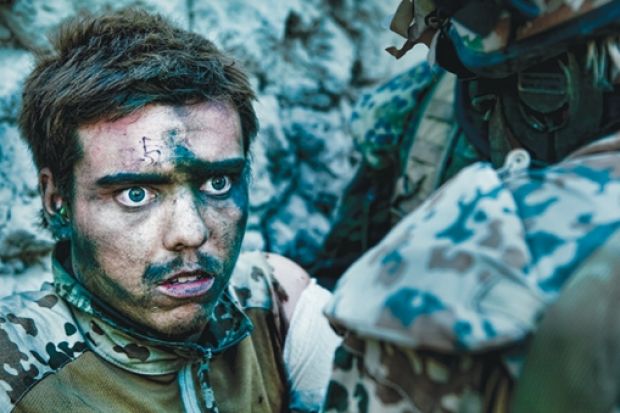Armadillo
Directed by Janus Metz
Released in the UK on 8 April
Photography and war have always gone together, much as we once thought love and marriage did, from Roger Fenton's early photographs of the Crimean War to the Abu Ghraib trophy photographs of US troops. Documentary film may have been born later, but war seems equally to be part of its DNA: The Battle of the Somme was a full-blown, and heavily censored, documentary made in 1916, seen by about 20 million people in its first six weeks.
Of course, we are now all so sophisticated that none of us believes that documentaries are, in any simple sense, real. As Maupassant said, realists are just the best liars. But watch a late sequence from Janus Metz's Armadillo, a box-office sensation in Denmark that follows a group of Danish soldiers on a tour of Afghanistan; watch as they explode a grenade into a ditch from where a group of Taliban are involved in a firefight; watch as the camera first reluctantly, then nervously, peers over the edge of the ditch; watch as it then moves shamelessly and closer to show what a grenade-hit face and body look like, actually look like - and then say that documentary is just another kind of fiction. At times, and this is one of those moments, it is defiantly not.
For much of the time, Armadillo, the name of a British-Danish base in Helmand province, is less visceral than the Taliban killing sequence, and works by mixing the usual war documentary ingredients, with no particular distinction. There are the tearful goodbyes to family as we are introduced to the men who will serve in Afghanistan (intercut here with images of the same young men in a striptease club before they depart), the welcome speeches from the officers, the harrowing tales from the men already there, the foot patrols, the engagement with the locals, the video war games that the soldiers play for recreation, the final and tearful return to Denmark. Like the soldiers in the recent feature film The Hurt Locker, these men don't quite belong when they do return home. They are sadder if not necessarily wiser.
Viewing Armadillo is like watching Waiting for Godot: nothing much happens for long stretches of time, but we know something will erupt, sooner or later. The killing of the Taliban fighters is one moment of disruption; another is a sequence when two of the Danish soldiers are shot in combat. One is pumped full of morphine and sits there in a trench like a rag doll with blank saucer-like eyes. It is for such moments that the close-up was invented.
The deaths of the Taliban fighters and the celebration afterwards, with the soldiers congratulating one another, one declaring that they had killed wounded men, led to a sustained furore in Denmark.
It is good to be reminded that documentary can create political waves - and there is no doubt that the continuing authority of such films is that they can take us to places and into communities that we, the audience, cannot normally enter; show us things usually not seen. Is there any place on earth more off limits to its audience - more inaccessible than even the Carmelite community in the recent documentary No Greater Love - than the trenches where soldiers crouch?
So perhaps that is why Armadillo has been garlanded with prizes from Cannes to London. It brings to light and confronts us with troubling and even harrowing actions done in our name. But there seems another reason why we are drawn to war - whether in a documentary such as Armadillo or a drama such as Peter Kosminsky's recent Channel 4 epic, The Promise.
At a time when cultural studies is full of accounts of the crisis of masculinity, a film like Armadillo gives us a radically different view of young men. The coming-of-age of these young Danish men is light years away from that of the young men studied in the recent Manning Up: How the Rise of Women Has Turned Men into Boys. The young men of Armadillo come of age by killing and dying on our behalf. The battlefield may be the last place on earth that this kind of manhood is sanctioned. To watch Armadillo is to connect these young men and us with a long history that throws us back, beyond even cinema and photography, to the Iliad.
Register to continue
Why register?
- Registration is free and only takes a moment
- Once registered, you can read 3 articles a month
- Sign up for our newsletter
Subscribe
Or subscribe for unlimited access to:
- Unlimited access to news, views, insights & reviews
- Digital editions
- Digital access to THE’s university and college rankings analysis
Already registered or a current subscriber? Login
